Summary
I’ve been a beekeeper for many years. I love the honey, but I love watching the bees even more. They are a fascinating example of a natural, decentralized system.
I installed a package of bees in a hive over the weekend. You buy bees in packages that contain 15-20 thousand bees and a queen. The queen is in a cage so she is easy to find. Queens give off a pheromone that attracts the other bees in the hive. The queen is the secret to creating legitimacy for the hive (see Legitimacy and Decentralized Systems for more on legitimacy). If the queen is in the new hive, chances are the other bees will see it as their legitimate home and stick around.
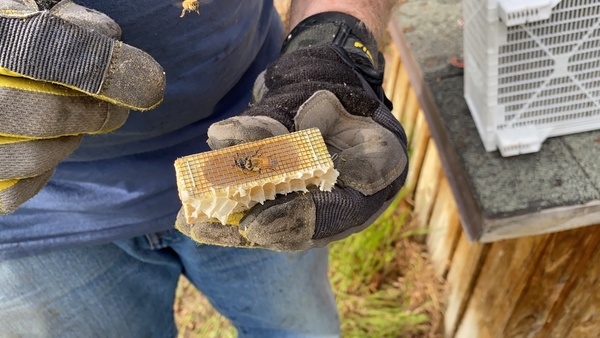
I placed queen cage in the hive using a rubber band to fix the cage on one of the frames that the bees make honeycomb on. I replaced the cork in the cage with a candy stopper. The bees eat through the candy over the course of a few days and free the queen. Hopefully, by that time, the hive is established and the bees stick around.
After placing the queen cage in the hive, you just dump the bees out on top of the frames. I love this part because thousands of bees are flying everywhere trying to make sense of what just happened. But over the course of an hour or two, the hive coalesces on the queen and most of the bees are inside, getting adjusted to their new home.
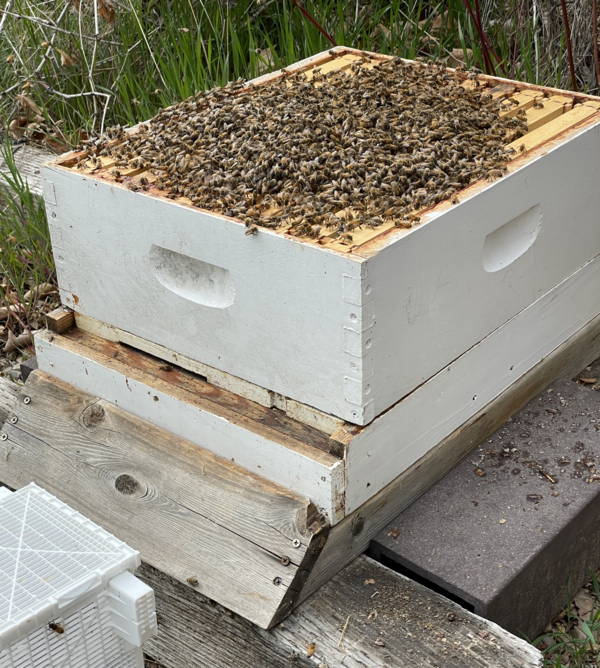
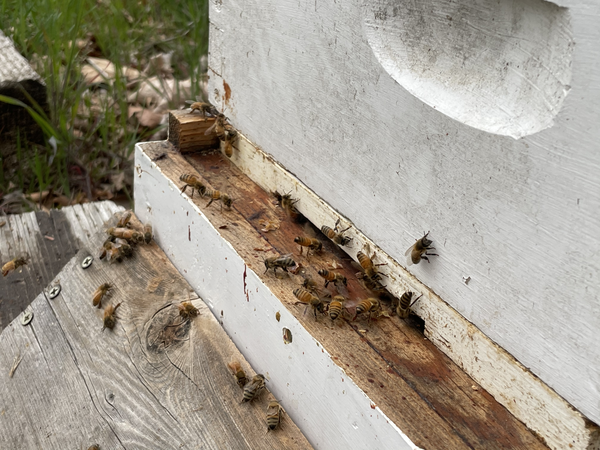
Besides providing a basis for hive legitimacy, the queen is also the sole reproductive individual, responsible for laying every egg that will be raised in the hive. This is a big job. During the summer, she will lay about 2000 eggs per day and the hive will swell to multiple tens of thousands of bees. But beyond this, the queen’s role is limited. She doesn’t direct the actions of the members of the hive. No one does.
Thermoregulation
So, how does the hive function without central direction? Thermoregulation provides an example. Despite the fact that bees themselves are not homeothermic, the hive is. The bees manage to keep the hive at 93-94°F (34°C) regardless of the outside air temperature.
How do the bees do that? The straightforward answer is that some bees go to the entrance of the hive and fan air to increase circulation when the internal temperature gets too high. When it gets too low, bees cluster in the center and generate heat by shivering.
The more interesting question is “how do the bees know to do that?” All the bees have similar genetic programming (algorithmic governance). But the tasks that they’re inclined to do depend on their age. The youngest workers clean cells, then move onto nursing functions, mortuary activities, guarding the hive, and finally, in the last weeks of their lives, to foraging for water, nectar, and pollen.
Bees have a genetic threshold for carrying out these tasks. The threshold changes as they age. A young bee has a very high threshold for foraging that decreases over her life. Further, these thresholds vary by patriline (even though every bee in the hive has the same mother, there are many fathers), providing diversity.
So as the temperature in the hive climbs, a few bees go down to the hive entrance and fan. As it gets hotter, even more bees will take up the task, depending on their internal threshold. Their genetic programming, combined with the diversity in their thresholds, promotes an even response to temperature swings that could damage the hive. You can read more about hive thermoregulation in an earlier blog post I wrote on the topic.
Swarming and Protecting Against Byzantine Failure
An even more interesting phenomenon is how bees decide to swarm. Because the hive is a super organism, the queen’s efforts to reproduce don’t result in a new hive unless there’s a swarm. Swarming is how new hives are created.
Bees swarm in response to stresses like insufficient food supply, too little space, and so on. But no one really knows how a hive decides it’s time to swarm. In preparation for a swarm, the hive starts to raise new queens. Whether an egg grows into a worker, drone, or queen is determined by how the larva is fed by nurse bees. At some point the bees collectively determine to swarm and the queen produces a pheromone that broadcasts that decision.
The swarm consists of the current queen (and her powerful pheromones), some of the worker bees, and a portion of the honey stores. The swarm leaves the hive and the remaining bees raise the new queen and carry on. The swarm flies a short distance and settles down on some convenient structure to decide where to make their permanent home. Again the swarm centers on the queen. This is where the fun starts.
Thomas Seeley of Cornell has been studying swarms for his entire career. In the following video he describes how bees use collective decision making to choose their new home.
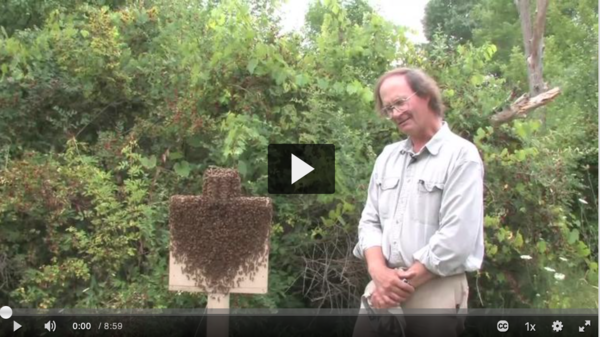
There are several interesting features in this process. First, Seeley has determined that bees don’t just make a good decision, but the best possible decision. I think that’s amazing. Several hundred bees leave the swarm to search for a new home and participate in a debate to choose one of the available sites and settle on the best choice.
This is a process that is potentially subject to byzantine failure. Not that the bees are malicious, in fact they’re programmed to accurately represent their findings. But they can report faulty information based on their judgment of the suitability of a candidate site. The use of reputation signals for sites and voting by multiple inspectors allows the bees avoid bad decisions even in the face of false signals.
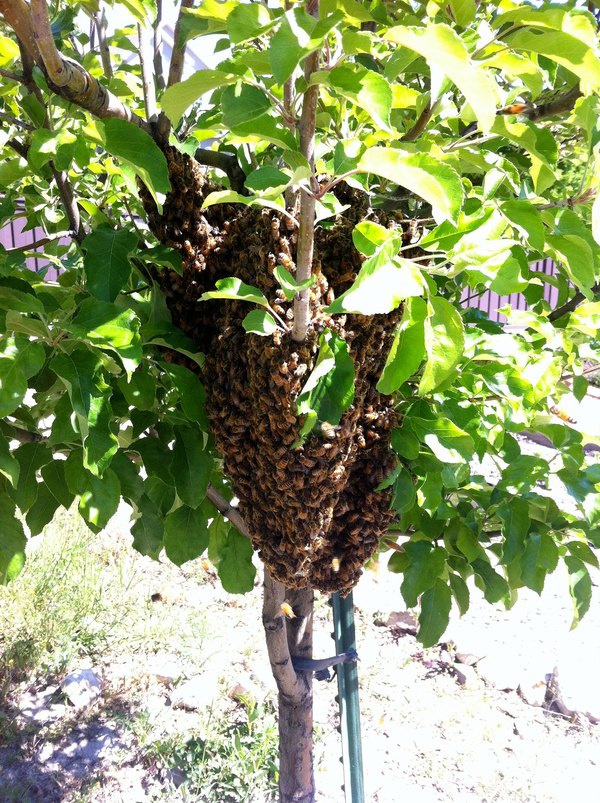
The process is further protected from error because bees are programmed to only advertise sites they’ve actually visited. Again, they don’t have the ability to be malicious. Each bee advertising a potential site has done the work of flying to the site and inspecting it. As bees signal their excitement for that site in a waggle dance, even more bees will fly out to it, perform an inspection, and return to advertise their findings. I don’t know if I’d characterize this as proof of work, but it does ensure that votes are based on real information. Once a quorum of bees in the swarm reach consensus about a particular site, the swarm departs and takes up residence in their new home.
Honeybee Democracy by Thomas D. Seeley
Honeybees make decisions collectively--and democratically. Every year, faced with the life-or-death problem of choosing and traveling to a new home, honeybees stake everything on a process that includes collective fact-finding, vigorous debate, and consensus building. In fact, as world-renowned animal behaviorist Thomas Seeley reveals, these incredible insects have much to teach us when it comes to collective wisdom and effective decision making.
You may not be thrilled if a swarm determines the best new home is in your attic, but you can be thrilled with the knowledge that ten thousand decentralized bees with sophisticated algorithmic programming achieved consensus and ranked it #1.
The hive is a super organism with its intelligence spread out among its tens of thousands of members. Life and death decisions are made on a daily basis in a completely decentralized fashion. Besides thermoregulation of the hive and finding a new home, the bees in a hive autonomously make millions of other decentralized decisions every day that result in the hive not only surviving but thriving in hostile conditions. I find that remarkable.




